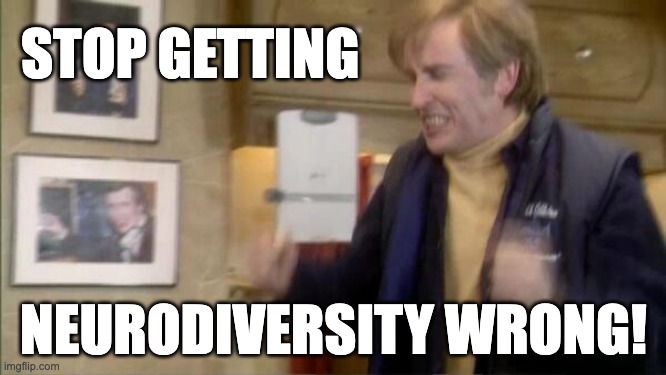The word ‘neurodiversity’ describes the whole, marvellous range of human perception – it was never intended to simply mean ‘different’. But with more and more people using it as a euphemism for ‘special needs‘, it’s time to talk about what neurodiversity actually means.
Last weekend, The Guardian published a fantastic piece written by neuroscientist Anil Seth about the diversity of human perception.
Seth’s research into how human brains interpret sensory information leads him to conclude that: “Just as we all differ on the outside, it’s likely that our inner experiences differ too.” Not only does this statement raise some fascinating philosophical questions about the very nature of reality, it is also offers a pretty neat definition of neurodiversity.
The word ‘neurodiversity’ is directly analogous to ‘biodiversity’ – i.e. human minds are as unique and infinitely variable as the individual trees within a forest. Not only is this variation natural, it is vital: a forest with a high degree of biodiversity is generally more resilient than one with only one type of tree, and a population with lots of variation in terms of how each of its inhabitants perceive the world is, evolutionarily speaking, more adaptive than one in which everyone thinks alike.
It seems that this is exactly what Seth is getting at when he talks about ‘perceptual diversity’. So why not just call it neurodiversity instead? Perhaps it is because of widespread confusion between two related but very different words: ‘neurodiverse’ and ‘neurodivergent’.
Diverse vs Divergent
As Seth quite rightly points out, “neurodiversity is typically associated with medically defined conditions such as autism or ADHD.” But just because the term neurodiversity is ‘typically associated’ with autism and ADHD doesn’t mean that they are actually the same thing.
Returning to the analogy between biodiversity and neurodiversity: we all understand that in a mixed woodland, every tree is of equal ‘value’ – whether it’s a pine tree or a willow tree. But our modern, Western world is not really a ‘mixed woodland’ – it’s more of a monoculture.
While we may purport to value innovation, creativity, and individuality, it is conformity, consistency, and compliance that are typically required (and rewarded) within all of our major social and industrial institutions – from schools to prisons; hospitals to care homes; offices to factories.
And clearly, a forest designed for pine trees is not ideal for willow trees.
This is obviously not a perfect analogy, because different species of tree are fundamentally separate. But it illustrates a useful point: any divergence from the average is generally unhelpful when the world in which you live is designed primarily to suit the typical majority.
Autism, ADHD, and other neurodevelopmental differences are simply the category labels that we tend to use to describe people whose minds work in a way that is significantly divergent from the average.
This kind of divergence is called ‘neurodivergence’. Autistic people are neurodivergent. ADHDers are neurodivergent. Dyslexics, dyspraxics, and dyscalculics are neurodivergent. Crucially, people who have dementia are also neurodivergent, as are people who are experiencing psychosis, or who have an acquired/traumatic brain injury. In the words of artist and writer Fergus Murray: “There are few, if any, totally neurotypical people; but some are certainly more neurotypical than others.”

(Image and caption are taken directly from ‘Neurodiversity is for everyone’ by Fergus Murray, 2019)
Reclaiming neurodiversity
I’ve written before about how the idea of ‘celebrating neurodiversity’ is often hijacked by those seeking to harness the more economically useful and/or socially acceptable strengths of neurodivergent minds.
Not only does this strengths-based narrative tend to minimise the significant challenges faced by many neurodivergent people, but it also ignores the fact that ‘neurodiversity’ means all of us.
A classroom full of autistic kids is no more ‘neurodiverse’ than a classroom full of non-autistic kids – just as a plantation of pine trees is no more ‘biodiverse’ than a plantation of willow trees, or a classroom with only Black children in it is no more ‘ethnically diverse’ than a class of exclusively white children.
Explaining the idea of ‘perceptual diversity’, Anil Seth says: “What is missed by the idea of neurodiversity is the possibility that every one of us sees the world in our own way, though not so markedly that the differences surface in how we behave or describe our experiences. […] And unlike the concept of neurodiversity, which tends to be reserved for specific conditions, perceptual diversity applies to all of us.”
But by dismissing neurodiversity as synonymous with ‘special needs’ – and so concluding that ‘perceptive diversity’ is a fundamentally novel concept – Seth is missing a vast and hugely exciting opportunity to learn from the countless academics, philosophers, and activists that have contributed to our collective understanding of neurodiversity.
Promoting neuro-curiosity
In challenging the ideas put forward by Seth, it is not my intention to dismiss his research or to suggest that his theories about perceptive diversity are wrong. In fact, I’m very much looking forward to reading his book on the science of consciousness, which I suspect contains much that will interest others who are curious about neurological diversity.
It is this idea of curiosity – specifically, neuro-curiosity – that I hope to promote and foster through the ZIG/ZAG project. Because the more we understand about ourselves and the nature of human consciousness, the more obvious it becomes that the very best kind of forest is one in which all diversity is truly understood, accommodated, and accepted.
A note on terminology:
Admittedly, it can be hard to get used to the ever-evolving language around neurodiversity. For anyone who is interested in learning more about terminology, autistic scholar Dr Nick Walker has an excellent guide to some basic terms and definitions on her blog, Neuroqueer.

Leave a comment